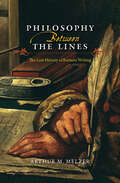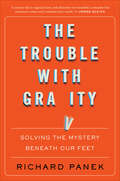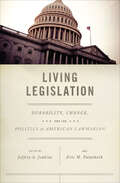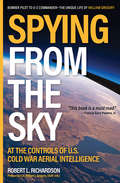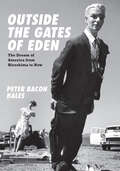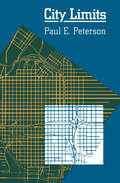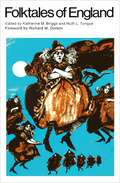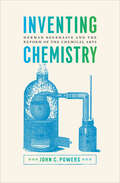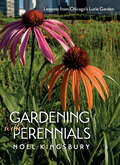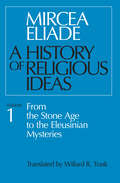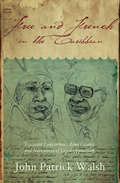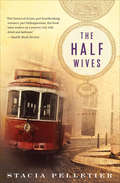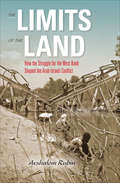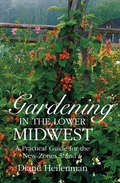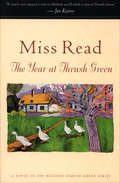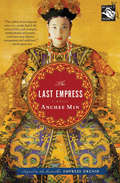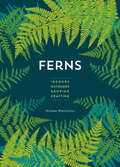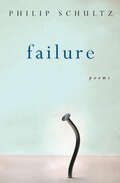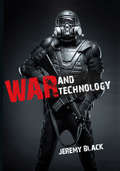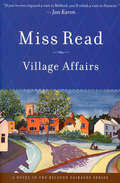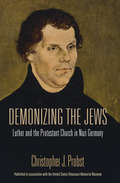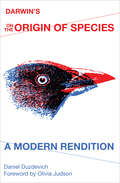- Table View
- List View
Philosophy Between the Lines: The Lost History of Esoteric Writing
by Arthur M. Melzer&“Shines a floodlight on a topic that has been cloaked in obscurity . . . a landmark work in both intellectual history and political theory&” (The Wall Street Journal). Philosophical esotericism—the practice of communicating one&’s unorthodox thoughts &“between the lines&”—was a common practice until the end of the eighteenth century. Despite its long and well-documented history, however, esotericism is often dismissed today as a rare occurrence. But by ignoring esotericism, we risk cutting ourselves off from a full understanding of Western philosophical thought. Walking readers through both an ancient (Plato) and a modern (Machiavelli) esoteric work, Arthur M. Melzer explains what esotericism is—and is not. It relies not on secret codes, but simply on a more intensive use of familiar rhetorical techniques like metaphor, irony, and insinuation. Melzer explores the various motives that led thinkers in different times and places to engage in this strange practice, while also exploring the motives that lead more recent thinkers not only to dislike and avoid this practice but to deny its very existence. In the book&’s final section, &“A Beginner&’s Guide to Esoteric Reading,&” Melzer turns to how we might once again cultivate the long-forgotten art of reading esoteric works. The first comprehensive, book-length study of the history and theoretical basis of philosophical esotericism, Philosophy Between the Lines is &“a treasure-house of insight and learning. It is that rare thing: an eye-opening book . . . By making the world before Enlightenment appear as strange as it truly was, [Melzer] makes our world stranger than we think it is&” (George Kateb, Professor of Politics, Emeritus, at Princeton University). &“Brilliant, pellucid, and meticulously researched.&” —City Journal
The Trouble With Gravity: Solving the Mystery Beneath Our Feet
by Richard PanekWhat is gravity? Nobody knows—and just about nobody knows that nobody knows. How something so pervasive can also be so mysterious, and how that mystery can be so wholly unrecognized outside the field of physics, is one of the greatest conundrums in modern science. But as award-winning author Richard Panek shows in this groundbreaking, mind-bending book, gravity is a cold case that&’s beginning to heat up. In The Trouble with Gravity, Panek invites the reader to experience this ubiquitous yet elusive force in a breathtakingly new way. Gravity, Panek explains, structures not only our bodies and our physical world, but also our minds and culture. From our very beginnings, humans&’ conceptions of gravity have been inextricably bound to our understanding of existence itself. As we get closer and closer to solving the riddle of gravity, it is not only physics that is becoming clearer. We are also getting to know ourselves as never before.
Living Legislation: Durability, Change, and the Politics of American Lawmaking
by William J. Novak Jeffrey E. Cohen David R. Mayhew William G. Howell Forrest Maltzman Matthew Eshbaugh-Soha Barry C. Burden Vesla M. Weaver Stuart Chinn Sidney M. Milkis Amihai Glazer Sean Gailmard David E. Lewis Charles R. Shipan Christopher R. BerryPolitical scholars examine the dynamic evolution of laws over time in a volume that &“pushes the frontiers of knowledge about lawmaking in the US&” (Choice). Politics is at its most dramatic during debates over important pieces of legislation. And while debates over legislative measures can rage for years or even decades before an item is enacted, they also endure long afterward, when the political legacy of a law eventually comes into focus. With a diverse set of contributors—including quantitative political scientists, political development scholars, historians, and economists—Living Legislation provides fresh insights into contemporary American politics and public policy. Many of the contributors to this volume focus on the question of why some laws stand the test of time while others are eliminated, replaced, or significantly amended. Others discuss how laws emerge from—and effect change within—coalition structures; the effectiveness of laws at mediating partisan conflicts; and the ways in which laws interact with broader shifts in the political environment. An essential addition to the study of politics, Living Legislation enhances understanding of democracy, governance, and power.
Spying from the Sky: At the Controls of US Cold War Aerial Intelligence
by Robert L. RichardsonThe &“must read&” story of America&’s first high-altitude aviation program and one of its pilots (Francis Gary Powers Jr.). William &“Greg&” Gregory was born into a sharecropper&’s life in the hills of North Central Tennessee. From the back of a mule-drawn plow, Greg learned the value of resilience and the importance of determined living. Refusing to accept a life of poverty, he found a way out: a work-study college program that made it possible for him to leave farming behind forever. While at college, Greg completed the Civilian Pilot Training Program and was subsequently accepted into the US Army&’s pilot training program. Earning his wings in 1942, he became a P-38 combat pilot and served in North Africa during the summer of 1943—a critical time when the Luftwaffe was still a potent threat, and America had begun the march northward from the Mediterranean into Europe proper. Following the war, Greg served with a B-29 unit, then transitioned to the new, red-hot B-47 strategic bomber. In his frequent deployments, he was always assigned the same target in the Soviet Union: Joseph Stalin&’s hometown of Tbilisi. While a B-47 pilot, Greg was selected to join America&’s first high-altitude program, the Black Knights. Flying RB-57D aircraft, he and his team flew peripheral &“ferret&” missions around the Soviet Union and its satellites, collecting critical order-of-battle data desperately needed by the US Air Force at that time. When the program neared its design end—and following the Gary Powers shoot-down over the Soviet Union—Greg was assigned to command of the CIA&’s U-2 unit at Edwards AFB. Over this five-year command, he and his team provided critical overflight intelligence during the Bay of Pigs, the Cuban Missile Crisis, the Vietnam buildup, and more. He also became one of the first pilots to fly U-2s off aircraft carriers in a demonstration project. Spying from the Sky is the in-depth biography of William Gregory, who attended the National War College, was assigned to the reconnaissance office at the Pentagon, and was named vice-commandant of the Air Force Institute of Technology (AFIT) before retiring from the force in 1972.
Outside the Gates of Eden: The Dream of America from Hiroshima to Now
by Peter Bacon HalesThe cultural historian and author of Atomic Spaces offers a comprehensive account of the Baby Boomer years—from the atomic age to the virtual age. Born under the shadow of the atomic bomb, with little security but the cold comfort of duck-and-cover drills, the postwar generations lived through—and led—some of the most momentous changes in all of American history. In this new cultural history, Peter Bacon Hales explores those decades through a succession of resonant moments, spaces, and artifacts of everyday life. Finding unexpected connections, he traces the intertwined undercurrents of promise and peril. From newsreels of the first atomic bomb tests to the invention of a new ideal American life in Levittown; from the teen pop music of the Brill Building and the Beach Boys to Bob Dylan&’s canny transformations; from the painful failures of communes to the breathtaking utopian potential of the digital age, Hales reveals a nation in transition as a new generation began to make its mark on the world it was inheriting. Outside the Gates of Eden is the most comprehensive account yet of the baby boomers, their parents, and their children, as seen through the places they built, the music and movies and shows they loved, and the battles they fought to define their nation, their culture, and their place in what remains a fragile and dangerous world.
City Limits
by Paul E. PetersonThis award-winning book &“skillfully blends economic and political analysis&” to assess the challenges of urban governments (Emmett H. Buell, Jr., American Political Science Review). Winner of the Woodrow Wilson Foundation Award for the best book published in the United States on government, politics, or international affairs Many simply presume that a city&’s politics are like a nation&’s politics, just on a smaller scale. But the nature of the city is different in many respects—it can&’t issue currency, or choose who crosses its borders, make war or make peace. Because of these and other limits, one must view cities in their larger socioeconomic and political contexts. Its place in the nation fundamentally affects the policies a city makes. Rather than focusing exclusively on power structures or competition among diverse groups or urban elites, this book assesses the strengths and shortcomings of how we have previously thought about city politics—and shines new light on how agendas are set, decisions are made, resources are allocated, and power is exercised within cities, as they exist within a federal framework. &“Professor Peterson's analysis is imaginatively conceived and skillfully carried through. [City Limits] will lastingly alter our understanding of urban affairs in America.&”—from the citation by the selection committee for the Woodrow Wilson Foundation Award
Folktales of England (Folktales of the World)
by Richard M. Dorson&“The most satisfactory general collection of folktales to come out of England since the advent of modern collection and classification techniques.&”—Journal of American Folklore Tales of unnatural beings, curses, and ghosts, tall tales, shaggy dog stories—this collection from a renowned British folklorist offers a wide historical range, as well as commentaries. If wonder tales are not as abundant in England as elsewhere, other kinds of folktales thrive: local traditions, historical legends, humorous anecdotes. Many of the favorite tales which English-speaking peoples carry with them from childhood come from a long tradition—stories as familiar to Shakespeare, Ben Jonson, Spenser, and their many contemporaries as they are to us. This volume is a &“fine, homely feast&” for anyone interested in the folklore of the world (Times Educational Supplement). &“Should be of special concern to Americans since many of the tales are parallel to or the source of our own folk stories.&”—Choice &“This is entertainment, to be sure, but is also part of man&’s attempts to comprehend his world.&”—Quartet
Inventing Chemistry: Herman Boerhaave and the Reform of the Chemical Arts (Synthesis)
by John C. PowersThe story of this little-known Dutch physician &“will interest students and practitioners of history, chemistry, and philosophy of science&” (Choice). In Inventing Chemistry, historian John C. Powers turns his attention to Herman Boerhaave (1668–1738), a Dutch medical and chemical professor whose work reached a wide, educated audience and became the template for chemical knowledge in the eighteenth century. The primary focus of this study is Boerhaave&’s educational philosophy, and Powers traces its development from Boerhaave&’s early days as a student in Leiden through his publication of the Elementa chemiae in 1732. Powers reveals how Boerhaave restructured and reinterpreted various practices from diverse chemical traditions (including craft chemistry, Paracelsian medical chemistry, and alchemy), shaping them into a chemical course that conformed to the pedagogical and philosophical norms of Leiden University&’s medical faculty. In doing so, Boerhaave gave his chemistry a coherent organizational structure and philosophical foundation, and thus transformed an artisanal practice into an academic discipline. Inventing Chemistry is essential reading for historians of chemistry, medicine, and academic life.
Gardening with Perennials: Lessons from Chicago's Lurie Garden
by Noel KingsburyA tour of a beloved botanic treasure that&’s &“brimming with ideas for every home garden&”—includes photos (The New York Times). For gardeners, inspiration can come from the most unexpected places. Perennial enthusiasts around the world might be surprised to find their muse in the middle of a bustling city. Lurie Garden, a nearly three-acre botanic garden in the center of Chicago&’s lakefront in Millennium Park, is a veritable living lab of prairie perennials, with a rich array of plant life that both fascinates and educates as it grows, flowers, and dies back throughout the year. Thousands of visitors pass through—and many leave wondering how they might bring some of the magic of Lurie to their own home gardens. In Gardening with Perennials, horticulturalist Noel Kingsbury brings a global perspective to the Lurie oasis through a wonderful introduction to the world of perennial gardening. He shows how perennials have much to offer home gardeners, from sustainability—perennials require less water than their annual counterparts—to continuity, as perennials&’ longevity makes them a dependable staple. Kingsbury also explains why Lurie is a perfect case study for gardeners of all locales. The plants represented in this urban oasis were chosen specifically for reliability and longevity. The majority will thrive on a wide range of soils and across a wide climatic range. These plants also can thrive with minimal irrigation, and without fertilizers or chemical control of pests and diseases. With a special emphasis on plants that flourish in sun, and featuring many species native to the Midwest region, Gardening with Perennials will inspire gardeners around the world to try Chicago-style sustainable gardening.
A History of Religious Ideas Volume 1: From the Stone Age to the Eleusinian Mysteries (A History of Religious Ideas #1)
by Mircea Eliade&“Everyone who cares about the human adventure will find new information and new angles of vision.&”—Martin E. Marty, The New York Times Book Review This extraordinary work delves into the subject of religion in the prehistoric and ancient worlds—humankind&’s earliest quests for meaning. From Neanderthal burials to the mythology of the Iron Age, to the religions of Mesopotamia, Egypt, Greece, Israel, India, and beyond, it offers both an appreciation of the wide-ranging diversity of religious expression—and a consideration of the fundamental unity of religious phenomena. &“Will arouse the interest of all historians of western religion, since it includes chapters on the religions of Canaan and Israel. However, the book must be read cover to cover if one wants to grasp the significance of its gigantic historical scope.&”—Church History
Free and French in the Caribbean: Toussaint Louverture, Aimé Césaire, and Narratives of Loyal Opposition (Blacks in the Diaspora)
by John Patrick Walsh&“All the ingredients to become the next important book in the field of postcolonial studies with the emphasis on French Caribbean culture and literature.&”—Daniel Desormeaux, University of Chicago In Free and French in the Caribbean, John Patrick Walsh studies the writings of Toussaint Louverture and Aimé Césaire to examine how they conceived of and narrated two defining events in the decolonializing of the French Caribbean: the revolution that freed the French colony of Saint-Domingue in 1803 and the departmentalization of Martinique and other French colonies in 1946. Walsh emphasizes the connections between these events and the distinct legacies of emancipation in the narratives of revolution and nationhood passed on to successive generations. By reexamining Louverture and Césaire in light of their multilayered narratives, the book offers a deeper understanding of the historical and contemporary phenomenon of &“free and French&” in the Caribbean. &“A fruitful intervention in a growing body of literature and increasingly lively debate on the Haitian Revolution and the figure of Toussaint Louverture, the book also contributes to the emerging scholarship on Césaire, Francophone literature, and postcolonial theory.&”—Gary Wilder, CUNY Graduate Center &“A valuable contribution to both the rapidly proliferating literature on the Haitian Revolution and the emerging revisionist appreciation of Césaire&’s intellectual and political project.&”—Small Axe &“J.P. Walsh has produced for the nonspecialist reader an excellent analysis of the historiographical discourse on Toussaint Louverture and Aimé Césaire with a focus on the meaning(s) of decolonization in the late eighteenth and mid-twentieth centuries.&”—New West Indian Guide &“That Free and French inspires so many questions is testament to its ambition, the provocative parallel at its heart, and the richness of Walsh&’s analysis.&”—H-Empire
The Half Wives: A Novel
by Stacia Pelletier&“Part historical fiction, part heartbreaking romance, part bildungsroman, this book takes readers on a journey rich with detail and darkness&” (Seattle Book Review). Henry Plageman is a master secret-keeper. A former Lutheran minister, he lost his faith after losing his infant son, Jack, many years ago; his wife, Marilyn, remains consumed by grief. But Henry has another life—another woman and another child—unknown to Marilyn. His lover, Lucy, yearns for a man she can be with openly while their eight-year-old daughter, Blue, tries to make sense of her parents&’ fractured lives The Half Wives follows these interconnected characters through one momentous day, May 22, 1897, the sixteenth anniversary of Jack&’s birth. Marilyn distracts herself with charity work. Henry needs to talk his way out of the police station, where he has spent the night for disorderly conduct. Lucy must rescue the intrepid Blue, who has fallen in a saltwater well. Before long, the four will be drawn to the same destination—the city cemetery on the outskirts of San Francisco—where the collision of lives and secrets leaves no one unaltered. A Finalist for the Townsend Prize &“The developing San Francisco of the 1890s becomes a rich background for these three as they play out their messy, somber, intertwined fates.&” —The New York Times Book Review &“A poignant, sometimes heart-rending, beautifully crafted, always gripping tale of loss and love, and the human need to try to set things right.&” —Kevin Baker, author of The Big Crowd &“Pelletier&’s writing is moving and enthralling . . . [She] keeps readers hooked right up to the book&’s satisfying conclusion.&” —Publishers Weekly
Military Low-Level Flying From F-4 Phantom to F-35 Lightning II: A Pictorial Display of Low Flying in Cumbria and Beyond
by Scott Rathbone"The author and his friends have been able to capture some truly remarkable images of modern military aircraft engaged in this activity - everything from a glider, to the massive and strange A400 Atlas, to Lockheed Martin F-35s." — Air ClassicsThe United Kingdom has some of the most dramatic landscapes that can be used by pilots to train in the vital skill of low flying. Aircrew preparing for operations in Afghanistan, Iraq and other potential war zones frequently hone their skills flying through the valleys of the UK, sometimes at near subsonic speed. In Cumbria, as well as other major training areas within the United Kingdom Low Flying System, such as parts of Scotland and the world-famous Mach Loop in Wales, pilots can be seen on an almost daily basis sharpening their skills as they weave their aircraft, from basic trainers to the latest high-tech fighters, between the hillsides. As a result, these locations offer remarkable opportunities for photographers to capture close-up and dramatic shots. These sights have captured the imagination of many photographers who have devoted many hours and displayed great patience in waiting to snap dynamic images on camera, the majority of these since the birth of digital photography. while photographs of military low flying prior to the digital age are rare, in the pages of this book the author presents a selection of images to showcase just how things have developed since the 1980s – particularly focusing on the action to be seen over the hills and valleys of Cumbria and the Lake District which, since 1979, has been a major area in the training of military pilots. In these pages are amazing shots of scores of different types of aircraft, from Jet Provosts, Buccaneers and Hawks through to F4 Phantoms, A-10 Thunderbolts, Tornadoes, Typhoons, and F-35 Lightnings, to name but a few. Types such as the Chinook and Sea King represent the many rotary aircraft. Unlike the photographs from air shows, none of these were staged; they are all action shots taken spontaneously as the aircraft whistled by Scott Rathbone and his trusty camera.
The Limits of the Land: How the Struggle for the West Bank Shaped the Arab-Israeli Conflict (Perspectives on Israel Studies)
by Avshalom Rubin&“An outstanding historical analysis of a core component to the current Middle East dilemma between Israel and the Palestinians.&”—Choice Reviews Was Israel&’s occupation of the West Bank inevitable? From 1949-1967, the West Bank was the center of the Arab-Israeli conflict. Many Israelis hoped to conquer it and widen their narrow borders, while many Arabs hoped that it would serve as the core of a future Palestinian state. In The Limits of the Land, Avshalom Rubin presents a sophisticated new portrait of the Arab-Israeli struggle that goes beyond partisan narratives of the past. Drawing on new evidence from a wide variety of sources, many of them only recently declassified, Rubin argues that Israel&’s leaders indeed wanted to conquer the West Bank, but not at any cost. By 1967, they had abandoned hope of widening their borders and adopted an alternative strategy based on nuclear deterrence. In 1967, however, Israel&’s new strategy failed to prevent war, convincing its leaders that they needed to keep the territory they conquered. The result was a diplomatic stalemate that endures today. &“Based on a meticulous examination of numerous Israeli, US, and British archives, as well as relevant Arabic and Russian literature, Avshalom Rubin covers the role of the West Bank in the Arab-Israeli conflict in a comprehensive way. His book stands alone at the top of work on Israeli-Jordanian relations of the period.&”—Robert O. Freedman, author of Israel and the United States: Six Decades of US-Israeli Relations
Gardening in the Lower Midwest: A Practical Guide for the New Zones 5 and 6 (Encounters: Explorations in Folklore and Ethnomusicology)
by Diane Heilenman&“A common-sense handbook for gardeners&” who live in the plant hardiness zones of the Midwest with extreme temperature swings (HortScience). Garden columnist Diane Heilenman helps novice and experienced gardeners cope in the difficult and trying climate of the areas she labels Zombie Zones, where wild temperature swings are normal—&“specifically, upper Kentucky; all of Ohio, Indiana, and Illinois; lower Iowa; all of Missouri; and the lower parts of Wisconsin and Michigan&” (Library Journal). She shows how to create gardens appropriate for the region and how to select flowers, plants, trees, and shrubs that will be happy—and in turn make us happy. A gifted thinker who grapples with what it means to garden in our time, Heilenman has produced a book that &“will help slacken the stress level that gardening was never meant to bring&” (HortScience). &“[Heilenman] gets to the heart, the soul and the humor shared by all in the gardening world . . . both a practical reference and an inspiration.&”—The Herald-Times (Bloomington, IN) &“Presents basic gardening techniques and personal plant preferences in a breezy writing style.&”—Library Journal
Got Sun?: 200 Best Native Plants for Your Garden (Encounters: Explorations in Folklore and Ethnomusicology)
by Carolyn HarstadThe author of Got Shade? and Go Native! turns out &“an ideal primer for gardeners who want to have lovely, sustainable and hospitable plantings&” (Moya Andrews, author of Perennials Short and Tall). Are you looking for more butterflies and birds in your yard? Do you enjoy seasonal color and beauty? Are you concerned about environmental issues such as water conservation and pollution control? Do you yearn for simple, maintenance-free gardening? Arranged in a question-and-answer format, Got Sun? showcases native trees, shrubs, ground covers, ferns, vines, grasses, and over 100 sun-friendly perennials for your home garden. Illustrated with detailed drawings and beautiful color photographs, this is a book to keep close at hand as you plan and plant your garden. &“Carolyn Harstad&’s passion for growing native plants is contagious. Her hands-on advice about plantings that attract butterflies will benefit experienced as well as novice (budding) gardeners. It is as if Carolyn takes the reader&’s hand and leads us through planning to preparation to selection of the best plants for each site. She is honest about any idiosyncratic behaviors as well as the charms of each plant so that we feel we know each of them, warts and all, before inviting them into our garden.&”—Moya Andrews, author of Perennials Short and Tall
The Year at Thrush Green: A Novel (The Beloved Thrush Green Series #12)
by Miss ReadA year in the life of your favorite English villagers from Thrush Green: &“Miss Read&’s novels are sheer delight&” (Chicago Tribune). Circling the seasons at Thrush Green, Miss Read returns to the Cotswold village already beloved by her readers. The snows of January yield to snowdrops and then daffodils. As the spring unfolds, so do the dramas of village life. Dotty Harmer serves up an herbal brew to her neighbor Albert Piggott, who has a soft spot for her despite his crusty façade. Architect Edward Young overhears a rumor that the old people&’s home he designed may be a bit cramped, and an American stranger arrives in search of family connections. At the Fuchsia Bush restaurant, Albert&’s wife, Nelly, finds herself in charge when the owner falls ill, and soon she receives two surprising gifts with implications for her past and her future. By year&’s end, these stories are satisfyingly intertwined, capturing a bygone era with the charm and humor that give Miss Read her enduring appeal. &“The more turbulent the real world, the more charming we may find the stability of Miss Read&’s tiny fictional world.&” —Los Angeles Times
The Last Empress: A Novel
by Anchee Min&“Admirers of Empress Orchid will be interested in this sequel. Others may find the introduction to relatively modern Chinese history a revelation&” (Rocky Mountain News). During the tumultuous end of the nineteenth century in China, the only constant was the power wielded by one person: the resilient, ever-resourceful Tzu Hsi, Lady Yehonala—or Empress Orchid—as readers came to know her in Anchee Min&’s critically acclaimed novel covering the first part of her life. In The Last Empress, Orchid moves from the intimacy of the concubine quarters into the spotlight of the world stage. Devastating personal losses take their toll, leaving her yearning to step aside, but only she—allied with the progressives, but loyal to the conservative Manchu clan of her dynasty—can hold the nation&’s rival factions together. Anchee Min offers a powerful revisionist portrait based on extensive research of one of the most important figures in Chinese history. Viciously maligned by the western press of the time as the &“Dragon Lady,&” a manipulative, blood-thirsty woman who held onto power at all costs, the woman Min gives us is a compelling, very human leader who assumed power reluctantly, and who sacrificed all she had to protect those she loved and an empire that was doomed to die. &“The vision of an empress who very nearly had it all: vulnerability and strength, motherhood and power, earthiness and dignity, compassion and ambition.&” —The Washington Post &“Invokes the intrigue and opulence of nineteenth-century China while telling the story of its improbably dominant ruler.&” —Los Angeles Times
Ferns: Indoors - Outdoors - Growing - Crafting
by Mobee WeinsteinA concise, creative, practical guide to growing these amazing plants, drawn from the award-winning volume The Complete Book of Ferns.A more concise version of The Complete Book of Ferns, focused on practical use for gardeners, Ferns offers botanical information, indoor and outdoor growing and care information, details on propagation, display ideas, and even craft projects. With numerous color photos, it will help you add a new dimension to your home or backyard garden reflecting the beauty and wide variety of this hardy plant that dates back to before the time of the dinosaurs.Acclaim for The Complete Book of FernsWinner of an American Horticultural Society Book Award“A lovely and multifaceted exploration . . . as useful as it is educational.” —Publishers Weekly
There's a Riot Going On: Revolutionaries, Rock Stars, and the Rise and Fall of the 60s
by Peter Doggett&“Doggett&’s encyclopaedic account of Sixties counter-culture is a fascinating history of pop&’s relationship with politics.&” —The Independent Between 1965 and 1972, political activists around the globe prepared to mount a revolution. While the Vietnam War raged, calls for black power grew louder and liberation movements erupted everywhere from Berkeley, Detroit, and Newark to Paris, Berlin, Ghana, and Peking. Rock and soul music fueled the revolutionary movement with anthems and iconic imagery. Soon the musicians themselves, from John Lennon and Bob Dylan to James Brown and Fela Kuti, were being dragged into the fray. From Mick Jagger&’s legendary appearance in Grosvenor Square standing on the sidelines and snapping pictures, to the infamous incident during the Woodstock Festival when Pete Townshend kicked yippie Abbie Hoffman off the stage while he tried to make a speech about an imprisoned comrade, Peter Doggett unravels the truth about how these were not the &“Street Fighting Men&” they liked to see themselves as and how the increasing corporatization of the music industry played an integral role in derailing the cultural dream. There&’s a Riot Going On is a fresh, definitive, and exceedingly well-researched behind-the-scenes account of this uniquely turbulent period when pop culture and politics shared the world stage with mixed results. &“A fresh and near-definitive slant on a subject you might have thought had been picked clean by journalists and historians.&” —Time Out London &“An extraordinary book . . . Doggett emerges triumphant. Grab a copy—by any means necessary.&” —Mojo
Failure: Poems
by Philip SchultzA Pulitzer Prize–winning poetry collection of &“heartbreaking tenderness&” (Gerald Stern). A driven immigrant father; an old poet; Isaac Babel in the author&’s dreams: Philip Schultz gives voice to failures in poems that are direct and wry. He evokes other lives, too—family, beaches, dogs, the pleasures of marriage, the terrors of 9/11, New York City in the 1970s (&“when nobody got up before noon, wore a suit/or joined anything&”)—and a mind struggling with revolutions both interior and exterior. Failure is a superb collection, &“full of slashing language, good rhythms [and] surprises&” (Norman Mailer). &“Philip Schultz&’s poems have long since earned their own place in American poetry. His stylistic trademarks are his great emotional directness and his intelligent haranguing—of god, the reader, and himself. He is one of the least affected of American poets, and one of the fiercest.&” —Tony Hoagland
War and Technology: Society, Technology, And War From Ancient Times To The Present (Encounters: Explorations in Folklore and Ethnomusicology)
by Jeremy Black&“[A] scholarly overview of military technology throughout history—starting roughly in the 15th century and extending into the future . . . insightful.&”—Publishers Weekly In this engaging book, Jeremy Black argues that technology neither acts as an independent variable nor operates without major limitations. This includes its capacity to obtain end results, as technology&’s impact is far from simple and its pathways are by no means clear. After considering such key conceptual points, Black discusses important technological advances in weaponry and power projection from sailing warships to aircraft carriers, muskets to tanks, balloons to unmanned drones—in each case, taking into account what difference these advances made. He addresses not only firepower but also power projection and technologies of logistics, command, and control. Examining military technologies in their historical context and the present centered on the Revolution in Military Affairs and Military Transformation, Black then forecasts possible future trends. &“Clear, concise, and thoughtful. An eminently readable synthesis of historical literature on technology and war.&”—John France, author of Perilous Glory: The Rise of Western Military Power &“An interesting, thought provoking work by a major military historian . . . whose depth and wide range of knowledge across the entire sweep of world military history is without parallel.... Those who read this book closely will be richly rewarded for it is a mine of useful information and grist for discussion.&”—Spencer C. Tucker, author of The European Powers in the First World War &“A most useful introduction to a very complex subject, and particularly valuable for its notes and references to other works. Provocative and vigorously argued . . . Highly recommended.&”—Choice
Village Affairs: A Novel (The Beloved Fairacre Series #13)
by Miss Read&“Delicious wit, quirky characters, [and] the colorful intrigues of daily life&” make Fairacre America&’s favorite English village (Jan Karon, #1 New York Times–bestselling author). The English village of Fairacre may appear idyllically peaceful to passersby, but those who live among its shady lanes always have problems to untangle. When a terrible rumor emerges—that the Fairacre School is to be closed and the children bused to nearby Beech Green—the village is up in arms at once. The schoolmistress, Miss Read, suffers agonizing indecision at the prospect, and her situation is made worse when her infants&’ teacher decides to leave and the short-tempered Mrs. Pringle becomes more contrary than ever. &“Affectionate, humorous, and gently charming . . . Sometimes funny, sometimes touching, always appealing.&” —The New York Times &“Miss Read reminds us of what is really important. And if we can&’t live in her world, it&’s certainly a comforting place to visit.&” —USA Today
Demonizing the Jews: Luther and the Protestant Church in Nazi Germany
by Christopher J. Probst&“An insightful analysis of the ways in which Protestant reformer Martin Luther&’s anti-Jewish writings were used by German Protestants during the Third Reich.&” —Contemporary Church History Quarterly The acquiescence of the German Protestant churches in Nazi oppression and murder of Jews is well documented. In this book, Christopher J. Probst demonstrates that a significant number of German theologians and clergy made use of the 16th-century writings by Martin Luther on Jews and Judaism to reinforce the racial antisemitism and religious anti-Judaism already present among Protestants. Focusing on key figures, Probst&’s study makes clear that a significant number of pastors, bishops, and theologians of varying theological and political persuasions employed Luther&’s texts with considerable effectiveness in campaigning for the creation of a &“de-Judaized&” form of Christianity. Probst shows that even the church most critical of Luther&’s anti-Jewish writings reaffirmed the antisemitic stereotyping that helped justify early Nazi measures against the Jews. &“A valuable contribution to our understanding of the churches under Nazism.&” —Lutheran Quarterly &“An insightful account of the convoluted echoes and reverberations of this deeply problematic aspect of Luther&’s legacy within German Protestantism over the longue durée.&” —German Studies Review
Darwin's On the Origin of Species: A Modern Rendition
by Daniel DuzdevichAn essential new edition of the 19th-century scientific masterpiece that translates Darwin&’s Victorian prose into modern English: &“Most useful&” (Walter Brock, Columbia University). Charles Darwin&’s most famous book On the Origin of Species is without question one of the most important books ever written. Yet many students have great difficulty understanding it. While even the grandest works of Victorian English can be a challeng for modern readers, Darwin&’s dense scientific prose is especially difficult to navigate. For an era in which Darwin is more talked about than read, doctoral student Daniel Duzdevich offers a clear, modern English rendering of Darwin&’s first edition. Neither an abridgement nor a summary, this version might best be described as a translation for contemporary English readers. A monument to reasoned insight, the Origin illustrates the value of extensive reflection, carefully gathered evidence, and sound scientific reasoning. By removing the linguistic barriers to understanding and appreciating the Origin, this edition brings 21st-century readers into closer contact with Darwin&’s revolutionary ideas.
